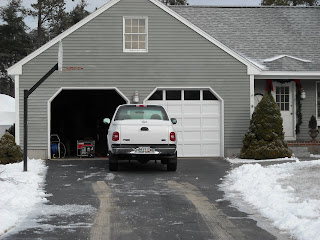
The graphic posted on this blog post shows the proper placement of a portable gasoline-powered generator. The photos on the 12/14/08 blog post are a few of the 30 or so photos I took of generators in southern Maine during last week's ice storm. They are all NOT properly placed because they are not far enough away from the houses.
So far we have tallied over 30 people in Maine with documented carbon monoxide poisoning from last week's storm. Preliminary analysis indicates that the vast majority were associated with misplaced generators. And, my own perusal of southern Maine indicates that is quite common. In fact, out of the 30 photos I took, not one is of a properly-placed generator! Consider a few facts:
Carbon Monoxide = CO is an odorless, tasteless, invisible and deadly gas.
CO is created from any combustion or burning of fuel.
In Maine, we have on average 150 people per year seen in emergency departments for CO poisoning, and 1 - 5 deaths.
The Maine 1998 ice storm - 2 deaths from CO poisoning, and well over 100 people were seen for CO poisoning in hospital emergency departments, mostly associated with the use of gasoline generators.
What can we do?
1. Know that gasoline-powered generators make a LOT of deadly carbon monoxide gas – one portable generator can produce the same amount of CO as 100 idling cars!! (http://blogs.consumerreports.org/safety/2006/12/growing_concern.html)
2. NEVER operate a generator in an enclosed or semi-enclosed space such as a basement, garage, barn, or enclosed porch. Doing so may send you and your family to the hospital and may even kill you.
3. Place generators outside far away (at least 20 feet) from any doors and windows that may allow CO gas back into the house, and make sure the exhaust is directed away from the house. Buy an appropriate electrical cord sufficiently long.
4. Keep generator and your hands dry to avoid electrocution. Many people use a canopy-like structure on a dry surface where water cannot reach the generator. It is important to plan ahead on where and how to place a generator safely outside of your home.
5. Have a working battery-operated CO alarm, especially if you have a generator. Only about 1/3 - 1/2 of Maine homes have a CO detector at all.
6. Do not use cooking equipment for heating inside - such as grills, stoves, or ovens.
7. Know that CO symptoms are: flu-like symptoms - headache, nausea, vomiting, dizziness - plus confusion and loss of consciousness. Some may have shortness of breath, palpitations, or chest pain. Often multiple people and pets are sick at the same time.
8. If the CO alarm goes off and you have symptoms, call 911 and get everyone
outside.
9. If you have questions call the Northern New England Poison Center at 1-800-222-1222.
A battery-operated CO detector makes a wonderful Christmas or Hanukkah gift!!













